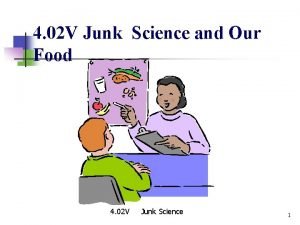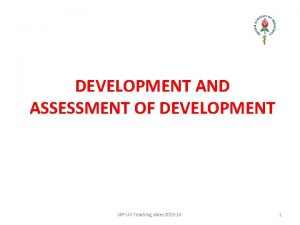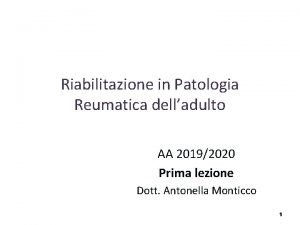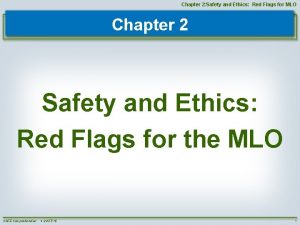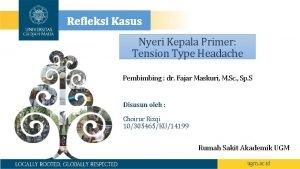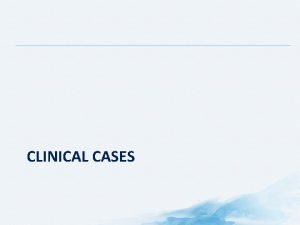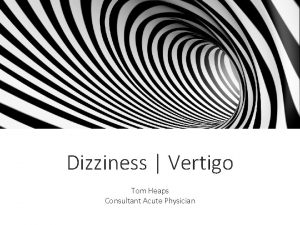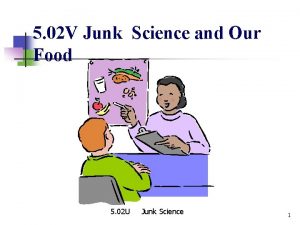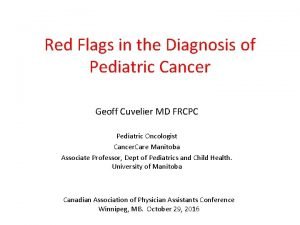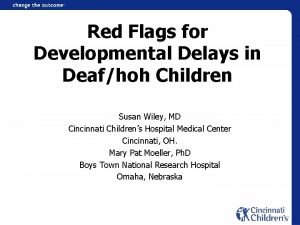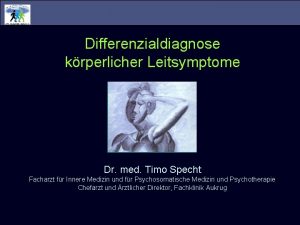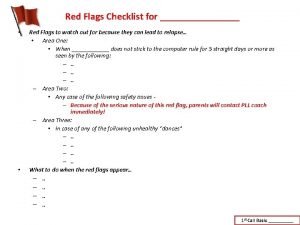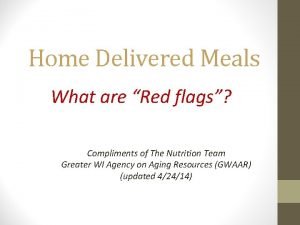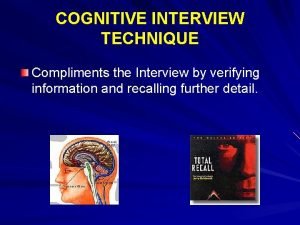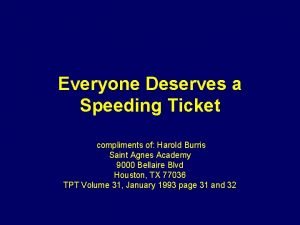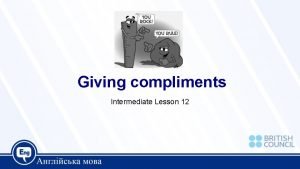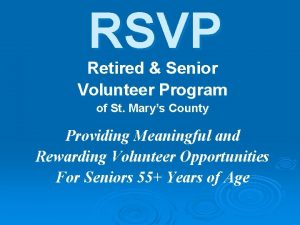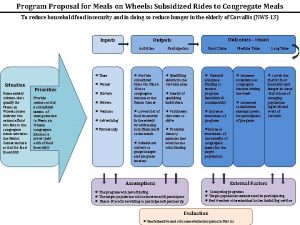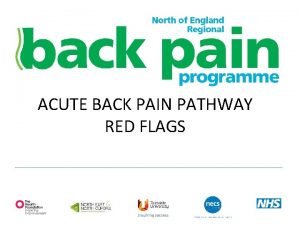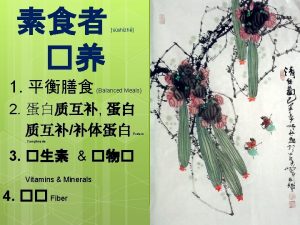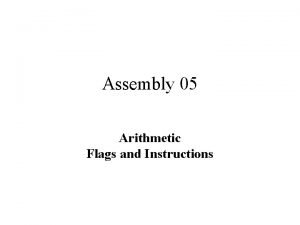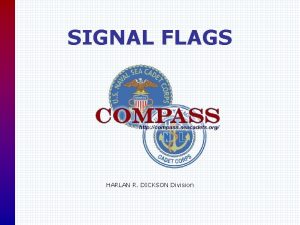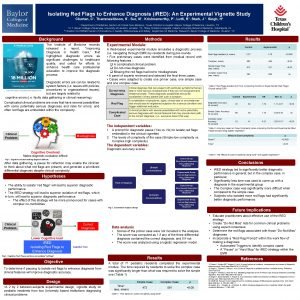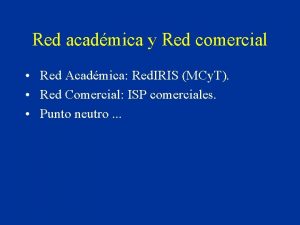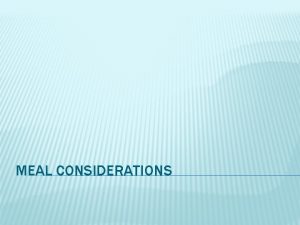Home Delivered Meals What are Red flags Compliments







































- Slides: 39

Home Delivered Meals What are “Red flags”? Compliments of The Nutrition Team Greater WI Agency on Aging Resources (GWAAR) (updated 4/24/14)

You are our eyes and ears and we need your help to keep people well and living independently.

10 Warning Signs that Someone May Need Additional Help 1. Changed eating habits, resulting in losing weight, having no appetite, or missing meals. 2. Neglected personal hygiene, including wearing dirty clothes and having body odor, bad breath, neglected nails and teeth, sores on the skin. 3. Neglected home, with a noticeable change in cleanliness and sanitation. 4. Exhibited inappropriate behavior, such as being unusually loud, quiet, paranoid, or agitated, or making phone calls at all hours. 5. Changed relationship patterns, causing friends and neighbors to express concerns. 6. Had physical problems, such as burns or injury marks, which may result from general weakness, forgetfulness, or misuse of alcohol or prescribed medications. 7. Decreased or stopped participating in activates that were once important to them, such as bridge or a book club, dining with friends, or attending religious services. 8. Exhibited forgetfulness, resulting in unopened mail, and piling of newspapers, not filling their prescriptions, or missing appointments. 9. Mishandling finances, such as not paying bills, losing money, paying bills twice or more, or hiding money. 10. Made unusual purchases, such as buying more than one subscription to the same magazine, entering an unusually large number of contests, or increasing purchases from television advertisements.

Nutrition Assessment All HDM participants should have a detailed assessment done to be sure they meet the program requirements, assesses their nutrition risk with the “DETERMINE” Screen and to make additional referrals as appropriate. These may include: • Medication Review • Adaptive Equipment Assessment • Falls Risk Assessment • Swallowing Evaluation • Nutrition Education or counseling to better control their condition.

The Nutrition Screening The DETERMINE checklists is part of the assessment that looks at who is at risk and may need additional support in the following area: • Social Services • Oral Health • Mental Health • Medication Use • Nutrition Education & Counseling • Nutritional Support

“DETERMINE” Nutrition Questions I have an illness or condition that made me change the kind and/or amount of food I eat. Yes = 2 I eat fewer than 2 meals per day. Yes = 3 I eat few fruits or vegetables or milk products. Yes= 2 I have 3 or more drinks of beer, liquor or wine almost every day. Yes= 2 I have tooth or mouth problems that make it hard for me to eat. Yes= 2 I don’t always have enough money to buy the food I need. Yes = 4 I eat alone most of the time. Yes= 1 I take 3 or more different prescribed or over-the-counter drugs a day. Yes = 1 Without wanting to, I have lost or gained 10 pounds in the last 6 months. Yes = 2 I am not always physically able to shop, cook and/or feed myself. Yes = 2 Good Nutrition 0 -2 Moderate Risk 3 -5 High Risk 6 or More

The DETERMINE Checklist is not the only way to determine RED FLAGS! YOU PLAY A KEY ROLE! • You provide daily socialization and caring that people look forward to and helps decrease depression and loneliness. • You are being trained to identify red flags that could potentially lead to costly consequences so timely and appropriate intervention can be taken so that hospitalization or re-admission can be avoided.

You’ve Got a Friend! "No other factors (diet, smoking, exercise, stress, genetics, drugs, surgery) have a greater impact on our quality of life, incidence of illness, and premature death from all causes than loneliness and isolation. " Dean Ornish, MD. You make their day and they make yours! You help decrease depression and loneliness through visitation and socialization.

The Home Visit Learn to read between the lines. What you’re told doesn’t equal what you see. Contradictions don’t always smack you in the face…know how to listen not just hear…know how to look not just see. “I just fell, I am so clumsy” (Elder abuse? Falls Assessment? ) “We don’t have that big of an appetite, we can just split a meal. ” (Economic hardship? Food Stamps Referral? ) “I don’t take all of these medications because I don’t need them. ” (Medication Review? )

Other Red Flags • “I have plenty of food, can I just get meals 3 days per week? ” • “I’m doing fine now. I would like to cancel. ” • “I’m only doing this because my kids want me to. ” • What are others that you have heard that seem like a red flag to you?

The Downward Spiral Anorexia Weight loss Malnutrition Depression Cognitive dysfunction Social withdrawal Isolation Giving up Death

Food For Thought… If up to 60% of older adults who are admitted to a hospital are malnourished, what are we missing in our screenings? Are we only looking at risk factors instead of indicators?

Indicators to Look For: • Presence of odors • Condition of countertops and table and cleanliness/maintenance of home • Condition of yard, sidewalks, driveway & steps • Can they get around in the house? Do they seem to sleep in the chair and stay on the first floor? • Do they have a way to reheat their food? • Post-it notes all around • Pets? Do they have pet food or do they split their meal with their pet?

(continued) • Condition of clothing (clean, size, condition). Do they need new or help with laundry? • Medications (is their a lot out in the open? ) • Nervousness or tremors • Voice tone…frail, booming, labored • Speaking openly or guarded so others won’t hear. • Recent falls • Family photos around

More Outward signs… Loss of muscle mass/strength Loss of subcutaneous fat, skin hanging. Fatigue/tiredness, apathy, memory loss, and new-onset falling Poor healing of wounds, sores, etc Loss of appetite Nausea Changes in bowel habits Pale coloring

The not-so-obvious • • • Change in denture fit Bleeding gums Numbness and tingling in extremities Impaired immune response (seem to be ill often) Muscle cramps Hair loss Nail loss Scaly and itchy or red skin Diarrhea Behavioral changes Bone fractures Edema (Swelling)

Signs, Signs Everywhere Signs… • Covered furniture • Piles of newspaper • Commode near “command central” • Is there a path for the walker? • Milk/Water jugs/Buckets around • Piles of unopened mail • Bathroom or home a mess • Depressed/lonely/hopeless

You are providing a “Daily Check” You may be the only contact the person has all day! Please complete the drivers “Red Flags Form” if: Call 9 -1 -1 if it’s an emergency. Don’t attempt to move someone, you could injure them. • Someone has fallen or appears very ill • You notice a moderate or major change in their status. • Their home looks unsanitary or unsafe. • You notice the person not eating their meals. • They have cuts or bruises • They seemed very confused and disoriented • Etc…. (See Red Flags form for more examples)

We Need Your Help! The assessment is done initially and once a year at minimum, more often if a concern is noted. We need your helps to let us know if you feel additional referrals or checks are warranted. For example, if you notice a lot of clutter, throw rugs, bruises on the person or they complain of falling or feeling dizzy, we need you to pass this information along to us by filling out the “Red Flags Form”. If you notice anything unusual in the neighborhood please complete the “Neighborhood Observation Notes”. The Aging Office will follow up in a very timely manner to help prevent hospitalization from medical complications or with the appropriate authority if safety issues are noted.

Complete Form

Neighborhood Observation Neighborhood Watch Skills Using Your “Eyes and Ears” Since you are in the neighborhood on a regular basis recognizing what is normal and what is not if the first step. What is a “Suspicious Activity”? Anything that feels uncomfortable or looks out of place. Some common examples include: • A stranger loitering in your neighborhood or a vehicle cruising the streets repeatedly. • Someone peering into cars or windows. • A high volume of traffic going to and coming from a home on a daily basis. • Someone loitering around schools, parks or secluded areas. • Strange odors coming from a house, building or vehicle. • Open or broken doors and windows at a closed business or unoccupied residence. • Someone tampering with electrical, gas or sewer systems without an identifiable company vehicle or uniform. • Persons arriving or leaving from homes or businesses at unusual hours. • Multiple persons who appear to be working in unison and exhibiting suspicious behaviors. • Signs of forced entry or tampering with security or safety systems. Always report suspicious activity and all crimes because we don’t know there’s a problem unless we are told. Never try to take action on your own. If it’s an emergency call 9 -1 -1 (Source Neighborhood Watch Manual www. usaonwatch. org )

Complete Form (Source Neighborhood Watch Manual www. usaonwatch. org )

The Follow Through! Identification of Red Flags is pointless if you don’t follow the protocols for follow-up. BE SURE TO TURN THE FORM IN RIGHT WHEN YOU GET BACK FROM THE ROUTE, WE NEED TO KNOW THIS INFORMATION IN A TIMELY MANNER. If it’s an emergency call 9 -1 -1 Thank you for your assistance!

Stories… • Take a few moments to share some stories of people you have encountered that had an emergency or had red flags that you encountered. • Share these stories with your legislators, they are powerful. Be sure to not use the persons real name to protect their confidentiality.

Thank you for All YOU DO!

Review of Specific conditions

Dehydration Dry tongue Dry mucous membranes Sunken eyes Loss of skin elasticity Headache Concentrated urine Upper body weakness Dizziness Rapid pulse Behavior & mood changes Fluid retention

Warning Signs of a Heart Attack Can strike anyone, anywhere, anytime. When a heart attack occurs, there is no time for delay. The symptoms may vary but the 3 usual ones are: Uncomfortable pressure, fullness, squeezing or pain in the center of the chest lasting for 2 minutes or more. Pain spreading to the shoulders, neck, jaw, arms or back. Lightheadedness, fainting, sweating, nausea, and/or shortness of breath. These signs aren’t always present. Many times a heart attack victim will experience some, but not all of these symptoms. And in some cases, the symptoms subside and then return.

Warning Signs of a Stroke: Signs of a stroke in progress often include sudden severe headache, vomiting, seizure activity, and stupor or coma. Onset is usually sudden and maximum intensity is reached within a few hours. Lesser grades of stroke may include some of these symptoms in lesser intensity. • • Headache, dizziness, drowsiness or mental confusion Sudden temporary weakness or numbness of the face, arm or leg. Temporary difficulty or loss of speech or trouble understanding speech. Sudden temporary dimness or loss of vision, particularly in one eye or an episode of double vision • Recent changes in personality or mental ability.

F. A. S. T. is an easy way to remember the sudden signs of stroke. When you can spot the signs, you'll know that you need to call 9 -1 -1 for help right away. • Face Drooping – Does one side of the face droop or is it numb? Ask the person to smile. Is the person's smile uneven? • Arm Weakness – Is one arm weak or numb? Ask the person to raise both arms. Does one arm drift downward? • Speech Difficulty – Is speech slurred? Is the person unable to speak or hard to understand? Ask the person to repeat a simple sentence, like "The sky is blue. " Is the sentence repeated correctly? • Time to call 9 -1 -1 – If someone shows any of these symptoms, even if the symptoms go away, call 9 -1 -1 and get the person to the hospital immediately. Check the time so you'll know when the first symptoms appeared.

Transient Ischemic Attack (TIA) Warning signs may be brief and, when left untreated, can lead to a major stroke. The symptoms of lightheadedness, feeling ill, numbness, or memory loss may last only a few seconds, but it is wise not to ignore them even if they go away. • Transient numbness, tingling or weakness in one arm or leg or on one side of the face • Temporary blindness in one or both eyes • Temporary difficulty with speech. • Loss of strength in a limb • Unusual or explainable headache, dizziness, drowsiness, nausea, or vomiting. Abrupt personality changes and impaired judgment or forgetfulness.

Congestive Heart Failure Weakness, tiredness Cough Shortness of breath, especially after physical activity Difficulty breathing when lying flat Weight gain Swelling of ankles and feet Frequent urination at night Persistent coughing.

High Blood Pressure Change in vision Chest pain Confusion Dizziness (blackout) Nausea and vomiting Nose bleeds Shortness of Breath

Kidney Disease Swelling of parts of the body, particularly around the eyes, ankles and wrists Low back pain, where the kidneys are located Burning sensation during urination Bloody or coffee colored urine High blood pressure Changes in the frequency of urination and/or in urine color.

Arthritis Redness, swelling or heat over a joint area Pain Stiffness after periods of rest Changes in the shape of a joint Aching at times of bad weather. Tiredness

Gout Pain in the big toe Swollen joints Redness Tenderness

Macular Degeneration Vision will be blurry or fuzzy Straight lines will appear wavy. Straight lines will be doubled or tripled Letters will appear jumbled.

Seizures A seizure is a sudden change in normal brain activity that makes a person act or move strangely. Signs of a Seizure: Being less alert Acting oddly Making strange movements Having strange feelings

What to do for a person during a seizure: DO: • • Do stay with the person Do keep calm Do move the person to a lying position Do turn the head and body to one side, if possible • Do move things away that could hurt the person (sharp or hard objects, etc. ) • Do protect the person’s head. • Do loosen tight clothes DON’T: • Do not force the mouth open • Do not put anything in the mouth. • Do not try to stop the person’s movements.
 Antigentest åre
Antigentest åre Red flags of junk science
Red flags of junk science Ug teaching slides
Ug teaching slides Balance sheet red flags
Balance sheet red flags Red flags lombalgia
Red flags lombalgia Occupancy fraud red flags
Occupancy fraud red flags Red flags nyeri kepala
Red flags nyeri kepala Red flags headache
Red flags headache Dizziness red flags
Dizziness red flags Red flags of junk science
Red flags of junk science Pediatric headache red flags
Pediatric headache red flags Black market peso exchange example
Black market peso exchange example Red flags for developmental delays
Red flags for developmental delays Bis red flags
Bis red flags Red flags alarmsymptome der medizin
Red flags alarmsymptome der medizin Red flags checklist
Red flags checklist Red flags cefaleia
Red flags cefaleia Food red flags
Food red flags Cognitive interview definition
Cognitive interview definition Ticket compliments
Ticket compliments Conversation congratulations
Conversation congratulations Compliments for idols
Compliments for idols Complement or compliment
Complement or compliment Gendered compliments
Gendered compliments Text generators
Text generators Compliments will get you nowhere
Compliments will get you nowhere Compliment examples
Compliment examples Write your answer on your notebook
Write your answer on your notebook Episcopal grace before meals
Episcopal grace before meals Hamburger termasuk makanan sepinggan
Hamburger termasuk makanan sepinggan Chapter 10 planning meals
Chapter 10 planning meals Eating together class 4 evs worksheet
Eating together class 4 evs worksheet In your notebook write questions about the subject
In your notebook write questions about the subject Mary's meals ceo salary
Mary's meals ceo salary Grace before meals bless us oh lord
Grace before meals bless us oh lord British meal schedule
British meal schedule Is your main meal of the day same as that in britain
Is your main meal of the day same as that in britain Meals on wheels st mary's county md
Meals on wheels st mary's county md Subsidized meals
Subsidized meals How to leave the world that worships should
How to leave the world that worships should

